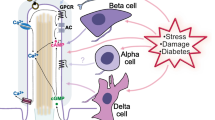Abstract.
Apoptotic cells in the taste buds of mouse circumvallate papillae after the sectioning of bilateral glossopharyngeal nerves were examined by the method of DNA nick-end labeling (TUNEL), together with standard electron microscopy. The taste buds decreased in number and size 3–11 days after denervation and disappeared at 11 days. The TUNEL method revealed only a few positively stained nuclei in normal taste buds but, in those of mice 1–5 days after denervation, the number of positive nuclei had increased to 3–5 times that of taste buds from normal mice. Electron-microscopic observation after denervation demonstrated taste bud cells containing condensed and fragmentary nuclei in a cytoplasm with increased density. The results show that taste bud cells under normal conditions die by apoptosis at the end of their life span, and that gustatory nerve sectioning causes apoptosis of taste bud cells with taste buds decreasing in number and ultimately disappearing.
Similar content being viewed by others
Author information
Authors and Affiliations
Additional information
Received: 20 November 1995 / Accepted: 15 May 1996
Rights and permissions
About this article
Cite this article
Takeda, M., Suzuki, Y., Obara, N. et al. Apoptosis in mouse taste buds after denervation. Cell Tissue Res 286, 55–62 (1996). https://doi.org/10.1007/s004410050674
Issue Date:
DOI: https://doi.org/10.1007/s004410050674




